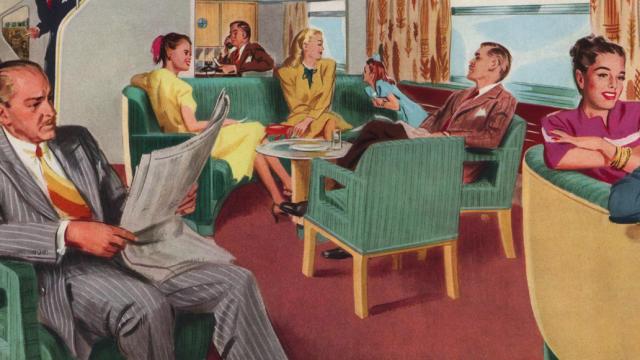Here in the 21st century, train travel isn’t seen as very futuristic. But in the years after World War II, trains were right up there with aeroplanes as the coolest in luxurious transportation of tomorrow. And, in 1947, Americans got a peek at what was promised to be their train-bound future.
It was called the Train of Tomorrow, first conceived by General Motors in 1944 simply as a scale model promotional tool. But after the war, people working on the project were excited enough that GM contracted with Pullman to actually build it. The train went out on a 28-month tour of the US and Canada and became a symbol of postwar promises for the future of getting around. Nearly six million people walked through the train as it toured, though a much smaller group got to actually travel on it.
The website Streamliner Memories has uploaded a fantastic colour brochure of the train from 1947. Many of the images below come from that brochure. A handful of other black-and-white photos come from the impressively detailed 2007 book Train of Tomorrow by Ric Morgan. The book is lovingly crafted and includes hundreds of photos and drawings, along with every possible fact you could ever want to know about the train — right down to a list of every different piece of glassware used.
The GM Train of Tomorrow had a brief existence touring North America and most of the cars that comprised it sat dormant after 1950, until they were finally sold off for scrap in the mid 1960s. But thanks to the magic of internet™ we can get a taste of what it must’ve been like to ride the train of the future.
Let’s tour the train, shall we?
The Astra Dome
The most impressive feature of the Train of Tomorrow was the Astra Dome. The desire to let passengers view the passing scenery with minimal obstruction is what inspired GM mangers to conceive of the train in the first place. It allowed passengers the most fantastic views, giving a perspective of the American landscape that most people had never seen before.
From the 1947 promotional booklet:
One of the many innovations on this train is the Astra Dome — a streamlined, thermopane, glass-enclosed penthouse built into the roof of every car. In it railroad passengers are afforded a sunlit or starlit view in every direction. Eye level is above ordinary car roof height. Laminated glass, the safety of which was proved in the windshields of thousands of bullet-swept warplanes, is used throughout.
Sky View dining car
Everybody needs to eat. And in the Train of Tomorrow they did it in style. Above we see actress Alice Faye with her husband as they enjoy dinner in the Sky View dining car.
From the 1947 promotional booklet:
This car provides table seating for 18 passengers in the Astra Dome, 24 in the main dining room and 10 more in the private dining room on the lower deck. Tables are uniquely arranged to afford more “moving around” room for everybody, including waiters. The Astra Dome offers all the advantages of roof garden dining — fine food, glamorous atmosphere, superb view. Refrigeration for food, air conditioning and water cooling are completely electric.
The Star Dust chair car
There really wasn’t a bad seat in the house. Even the most dense seating on the train had comfy reclining seats. That guy in the green tie sure looks happy, doesn’t he? And I know that promotional illustrations can’t lie.
From the 1947 promotional booklet:
This ultramodern chair car accommodates 72 persons in complete comfort. It is equipped with gloriously restful reclining seats, individually lighted. The three rooms under the Astra Dome are semi-private, ideal for family travelling. Spacious overhead luggage racks, rubber flooring under seats and heavily aisles complete the picture of travel luxury at moderate cost.
Dream Cloud sleeping car
The sleeping cars provided relatively spacious accommodations, with some beds that folded out from a couch, and others that folded from the wall.
From the 1947 promotional booklet:
The luxurious sleeper car, accommodating 20 passengers, includes three compartments underneath the Astra Dome, two drawing rooms at the forward end, and 8 duplex roomettes at the rear. They are furnished with such comforts of home as full-length wardrobes and mirrors. Matchless daytime comfort is provided, too, by full size lounges, restful chairs, and the space to enjoy them in privacy.
Moon Glow observation car
The Train of Tomorrow also had incredibly glamorous lounges where people could enjoy a cocktail or just read the newspaper.
From the 1947 promotional booklet:
A car for your leisure hours en route. Nothing has been overlooked that might contribute toward your enjoyment of the trip. The observation compartment in the rear affords a magnificent view of the swiftly changing landscape, through wide picture windows. There are two cocktail lounges, furnished much like their counterparts in the smart supper clubs and hotels. A writing desk occupies a semi-private nook; telephone services is available to your home or business.
Again, this is but a small peek at the wonderful future-ness that was GM’s Train of Tomorrow. If you have any desire to learn more about the train, I can’t recommend Ric Morgan’s 2007 book Train of Tomorrow highly enough.
Pictures: Train of tomorrow dining room and cutaway illustration of the train scanned from the 1990 book The American Design Adventure; Colour illustrations from the GM Train of Tomorrow brochure via Streamliner Memories; The American Railway Passenger Car Parts I and II; Other black and white photos scanned from Train of Tomorrow by Ric Morgan
